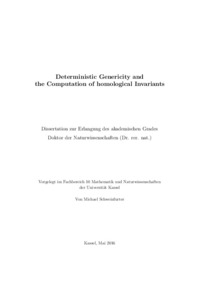| dc.date.accessioned | 2016-08-10T07:44:47Z | |
| dc.date.available | 2016-08-10T07:44:47Z | |
| dc.date.issued | 2016-08-10 | |
| dc.identifier.uri | urn:nbn:de:hebis:34-2016081050653 | |
| dc.identifier.uri | http://hdl.handle.net/123456789/2016081050653 | |
| dc.language.iso | eng | |
| dc.rights | Urheberrechtlich geschützt | |
| dc.rights.uri | https://rightsstatements.org/page/InC/1.0/ | |
| dc.subject | (Strongly) Stable Ideals | eng |
| dc.subject | Quasi-stable Ideals | eng |
| dc.subject | Borel-fixed Ideals | eng |
| dc.subject | Pommaret Basis | eng |
| dc.subject | Reduction Number | eng |
| dc.subject | Weakly D-Minimal Stable Ideals | eng |
| dc.subject | weakly D-stable | eng |
| dc.subject | β-Maximality | eng |
| dc.subject.ddc | 510 | |
| dc.title | Deterministic Genericity and the Computation of homological Invariants | eng |
| dc.type | Dissertation | |
| dcterms.abstract | The main goal of this thesis is to discuss the determination of homological invariants of polynomial ideals. Thereby we consider different coordinate systems and analyze their meaning for the computation of certain invariants. In particular,
we provide an algorithm that transforms any ideal into strongly stable position if char k = 0. With a slight modification, this algorithm can also be used to achieve a stable or quasi-stable position. If our field has positive characteristic, the Borel-fixed position is the maximum we can obtain with our method. Further, we present some applications of Pommaret bases, where we focus on how to directly read off invariants from this basis.
In the second half of this dissertation we take a closer look at another homological invariant, namely the (absolute) reduction number. It is a known fact that one immediately receives the reduction number from the basis of the generic initial ideal. However, we show that it is not possible to formulate an algorithm – based on analyzing only the leading ideal – that transforms an ideal into a position, which allows us to directly receive this invariant from the leading ideal. So in general we can not read off the reduction number of a Pommaret basis. This result motivates a deeper investigation of which properties a coordinate system must possess so that we can determine the reduction number easily, i.e. by analyzing the leading ideal. This approach leads to the introduction of some generalized versions of the mentioned stable positions, such as the weakly D-stable or weakly D-minimal stable position. The latter represents a coordinate system that allows to determine the reduction number without any further computations. Finally, we introduce the notion of β-maximal position, which provides lots of interesting algebraic properties. In particular, this position is in combination with weakly D-stable sufficient for the weakly D-minimal stable position and so possesses a connection to the reduction number. | eng |
| dcterms.accessRights | open access | |
| dcterms.creator | Schweinfurter, Michael | |
| dc.contributor.corporatename | Kassel, Universität Kassel, Fachbereich Mathematik und Naturwissenschaften, Institut für Mathematik | |
| dc.contributor.referee | Seiler, Werner M. (Prof. Dr.) | |
| dc.contributor.referee | Koepf, Wolfram (Prof. Dr.) | |
| dc.subject.msc | 13P10 Gröbner bases; other bases for ideals and modules | ger |
| dc.subject.msc | 13P20 Computational homological algebra | ger |
| dc.subject.msc | 13D02 Syzygies, resolutions, complexes | ger |
| dc.date.examination | 2016-07-19 | |

